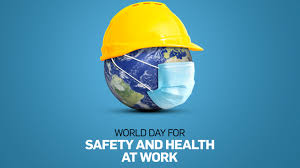WORLD DAY FOR SAFETY AND HEALTH AT WORK

In 2003, The international Labour Organization(ILO), began to observe World Safety And Health Day in order to stress the prevention of accidents and diseases at work, capitalizing on the ILO’s traditional strengths of tripartism and social dialogue.
The World Day for Safety and Health at work is celebrated every year on 28 April and aims to prevent occupational accidents and diseases. The day focuses on promoting a culture of safety and health. This day is observed to place occupational safety and health (OSH) on the international and national agendas; and to provide support to the national efforts for the improvement of national OSH systems.
Over the years, the day has become a significant tool to raise awareness of how to make safe and healthy and of the need to raise the political of occupational safety and health. 28 April is also the International Commemoration Day For Dead And Injured Workers.
This year’s theme for World Day for safety and Health at work is ‘Participation And Social Dialogue In Creating A Positive Safety And Health Culture’.
It is observed that everyday, 6,300 people die as a result of occupational accidents or work-related diseases – more than 2.3 million deaths per year. 317 million accidents occur on the job annually; many of these resulting in extended absences from work. The human cost of this daily adversity is vast and the economic burden of poor occupational safety and health practices is estimated at 4 per cent of Global Gross Domestic Product each year.
Safety in the workplace is still a bourgeois concept in many parts of the world. It is because, in some places, the value of human life is surpassed by the demands in this industrial, mass-producing world. Hence, the annual World Day for Safety and Health at work highlights the importance of occupational safety and health.
A thing to be noted is that the impetus to maintain good standards of safety and health is spread out evenly among all the sectors of society. This means that for the policymakers, it is their responsibility to chart out laws and regulations that ensure employability. For employers, it is their duty to ensure that the work environment is safe and healthy. The onus to work safely and prioritise their health is on the employees.
 The main goal of safety and health programs is to prevent workplace injuries, illness, and deaths, as well as the suffering and financial hardship these events can cause for workers, their families and employers.
The main goal of safety and health programs is to prevent workplace injuries, illness, and deaths, as well as the suffering and financial hardship these events can cause for workers, their families and employers.
Business owners and employers hold the most responsibility when it comes to workplace health and safety. They are legally required to keep their employees and anyone who might be affected by their business safe from harm, including customers, visitors to the workspace, temporary workers and contractors.
Here are some steps to improve workplace safety;
- Train employees well.
- Reward employees for safe behavior.
- Partner with occupational clinicians.
- Use labels and signs
- Keep things clean.
- Make sure employees have the right tools and have regular equipment inspections.
- Encourage stretch breaks.
- Implement safety protocols from the start.
- Keep an open dialogue.
- Have regular meetings on workplace safety.
As an employer, it’s your responsibility to protect your employees and provide a safe workplace. Use these ten(10) tips to get started.
